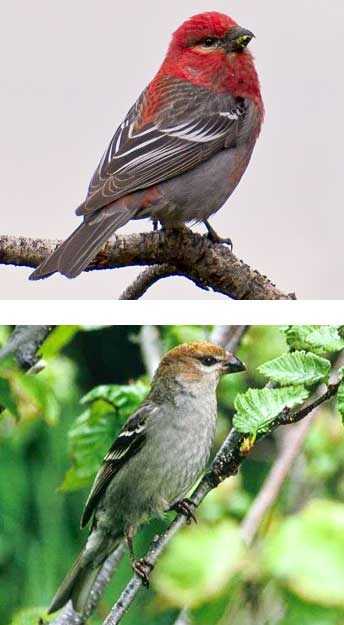
Bottom: Females have an olive colored head. NPS Pinicola enucleatorLength: 7.9-9.8 in (20-25 cm) - Wingspan: 13 in (33 cm) General DescriptionMale Pine Grosbeaks have a pinkish-red head, breast, back and rump, streaked back, and white under tail coverts. Males also have Blackish brown wings and tail with white wingbars and tertial edges. The juvenile males are usually indistinguishable from immature or adult female until the second year when it molts and grows new reddish feathers. Some young males have some red or orange feathers in the body plumage, which females apparently lack. The adult females have a yellowish olive head and rump. The females have gray under parts and back while their wings and tail are Blackish brown. They also have white wingbars and tertial edges. HabitatPine Grosbeaks breed in sub-arctic and boreal conifer forests. They generally breed in wet areas or other openings near the tree line. Their non-breeding habitat is determined by available food, but often contains mountain ash, ash, maple, and other broadleaved trees. BehaviorPine Grosbeaks are typically found in pairs during the breeding season, but form larger flocks the rest of the year. They forage on the ground, in trees, shrubs, and in the air. They are attracted to 'Pygmy-Owl tooting,' a common practice of birders used to imitate a Pygmy-Owl and attract birds. They often allow very close approach by humans, but may be missed because they will sit motionless. Found in flocks in winter; strongly territorial in breeding season. DietThe Pine Grosbeask will eat seeds, fruit, buds, and berries. They feed insects and spiders to their young, but adults eat more than 90% vegetable matter throughout the year. NestingPine Grosbeaks are generally monogamous, and form pairs before they arrive on the breeding grounds. The nest is typically located in dense foliage on a horizontal branch near the trunk of a tree, or in a vertical fork. The female builds the nest, which is a bulky, open cup of twigs and rootlets, lined with fine grass, moss, rootlets, and lichen. Eggs & IncubationThe eggs of a Pine Grosbeak are generally bluish green without markings. The female incubates three to five eggs for 13 to 14 days. The male brings food to the female on the nest. Both members of the pair feed the young, which leave the nest after about 15 days. The young can fly well within a few days of hatching, but continue to beg for food from their parents for some time after fledging. Pairs generally raise one brood each season. Migration StatusThe Pine Grosbeak is a non-migratory bird but occasionally irruptions can occur in years when food is less abundant. Interesting Facts
|
Last updated: May 4, 2018
